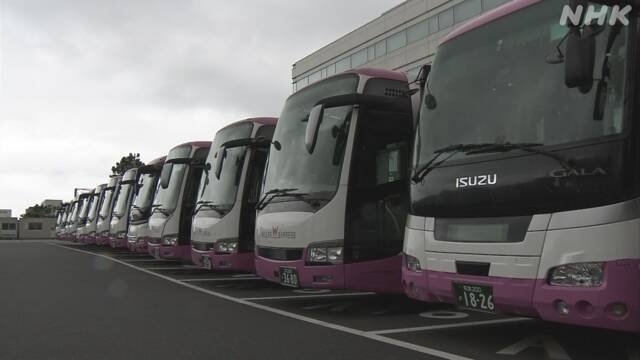Highway bus companies strengthened measures to prevent corona infection, including thorough ventilation, and restarted operation at 1:49 on June 1
k10012453041_202006011146_202006011150.mp4
Due to the effects of the new coronavirus, express bus companies departing and arriving in Tokyo, which had been suspended for a while, are moving to resume operation after strengthening infection control measures such as thorough ventilation inside the vehicle.
Following the cancellation of the emergency declaration nationwide last month, highway bus companies are gradually restarting operations from the 1st.
Of these, the highway bus company in Koto, which has reopened on seven routes connecting Shinjuku-ku, Shinjuku-ku, Tokyo with Osaka, Nagoya, etc., has a ventilation system that can replace the air inside the car in about 5 minutes to avoid so-called "3 denseness". We are taking new measures such as utilizing functions and reducing the number of seats provided to half, and equipping each seat with a disposable face cover that covers the face.
On the morning of the 1st, before the departure, the driver checked the equipment inside the vehicle and set the mode to introduce the outside air of the air conditioner.
The company has suspended all 290 flights a day, 20 routes all over the country, but we are considering resuming operation in the future based on the infection situation.
“WILLER EXPRESS” spokeswoman Miho Seike said, “There are people who need to be moved to restart, so we will take proper measures to prevent infection and ensure safe and secure operation.”
Ventilation function for large buses
For high-speed buses and sightseeing buses that run long distances, we are working on "3 dense" measures such as always operating the "outside air introduction mode" of the air conditioner that takes in outside air at full operation.
In a test of the ventilation function of a large-sized bus announced by Chuo Kotsu, which has its headquarters in Kawaguchi City, Saitama Prefecture, white smoke that filled the inside of the car was discharged from the exhaust port, and the air inside the car was replaced in about 5 minutes.
According to the company, this has the same ventilation capacity as natural ventilation with all windows open, so even if the windows cannot be opened while driving on the highway or due to rain, etc. Is that you can avoid.
In addition, each bus company will reduce the number of seats provided to prevent passengers from "crowding" by spacing passengers, and by installing a disposable face cover on the seats to eliminate "closeness" to prevent splash infection. And so on.
On the other hand, route buses do not have an "outside air introduction mode" for air conditioners, but it means that the inside of the vehicle is ventilated by opening and closing the doors when getting on and off.
In addition, many route buses have an air intake in front of the vehicle and exhaust vents and ventilation fans in the front and rear of the room, so the air inside the car is about 3 to 5 minutes even when all the windows are closed. It means that you can replace with.
Bus companies call for staggered commuting to avoid congestion and to wear masks and keep conversations low.

